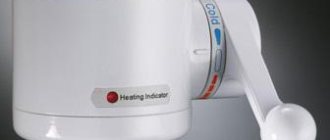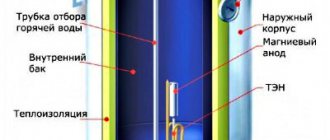Tools and materials when turning off the boiler
You can turn off the boiler on the control panel, but you won’t be able to drain the water completely.
You will need a variable-size adjustable wrench with movable jaws made of tool steel to disconnect the pipes. Use a wrench to unscrew the bolts attaching to the partition. No tool is needed if the boiler is hanging on hooks.
A hose is being prepared for the return valve or liquid inlet. Use a Phillips screwdriver to detach the safety cap. Flat-head (slotted) screwdrivers are needed to pry it up and pull it out of a tight socket.
For no more than a week
What is the correct way to turn off the water heater during this period? In this situation, the best option would be to disconnect the device from the network, and leave the liquid in the tank.
Since turning off the device using the “turn off” button on the device will not protect it from voltage surges, which we periodically experience, since not everyone has voltage stabilizers installed.

Disconnecting the boiler from the network
Instructions for turning off the boiler
Before releasing the boiler, preparatory work is carried out.
- De-energize the unit. The plug is pulled out of the socket or the machine is turned off. Take an indicator screwdriver and check the presence of electricity on the contacts.
- The water supply tap in the apartment is turned off. If this is not the case, the flow of liquid is stopped by a valve in the basement.
You can empty the boiler of water only after it has cooled down. After turning off the electrics, you need to wait for the liquid to cool. Then the pipes through which water is supplied are removed from the boiler.
Long term shutdown

Sometimes you need to turn off the boiler for the winter and drain the water. Microorganisms multiply in liquids without heating. If the unit is located in an unheated building, the water will freeze and the boiler tank will rupture. It is recommended to turn off and dismantle the heater if the unit is to be changed or the room is decorated.
Boiler shutdown sequence:
- stop heating by turning off the heater from the network;
- turn off the cold and warm liquid supply taps going to the unit, the water will remain in the tank and will not drain;
- open the check valve on the housing.
Sometimes there is an auto-valve that provides water supply to other rooms in conditions of hard wiring.
Disconnection with dismantling
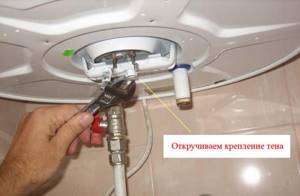
The boiler must be turned off and removed from the partition. You cannot dismantle a boiler whose tank is filled with liquid inside; it must be drained to reduce the weight of the tank.
Procedure for draining and dismantling:
- close the valve on the hot tube;
- place a vessel for drainage or direct the hose into the bath;
- disconnect the junction of the cold riser and the protective hydraulic valve;
- unscrew the nut connecting the valve to the cold line fitting;
- regulate the flow by opening the valve;
- the water will go away in a few minutes.
It is not difficult to remove the unit if it is located on hooks. Dismantling requires care to avoid damaging parts.
Turning hot water off and on
The city main can start working again, then you can turn off the boiler if you have hot water. The plug is removed from the socket and the contents cool down. You can drain half the liquid and add cool to make the process faster.
To drain, close the tap on the cold pipeline and disconnect the corresponding pipe. A hose is attached to the free end and placed in the sink. The valve is unscrewed and the drain valve opens. The water mixer turns to the hot position. After this, the supply valve from the city water supply is turned on.
Do I need to drain the water?
Usually the remaining water in the boiler is not drained. It remains in the water heater until the next time it is turned on, provided that the period of inactivity is short. If you turn off the boiler for several weeks or months, the water must be drained. Otherwise, oxidation or scale formation may occur, which will shorten the service life of water heating equipment.

It is necessary to drain the water after the boiler is disconnected from the power supply in poorly heated housing. In a home with low temperatures, water can freeze and rupture the water heater. To eliminate any remaining water, you should use a check valve. It is located on the equipment body.
Reasons for turning off the boiler and recommendations for self-de-energization

The mothballing of the unit is carried out in conditions where the temperature in the house drops below +5°C. You cannot leave the heater without water for a long time, as oxygen causes corrosion. Regular use of the unit also requires periodic cleaning of rust.
Scale works as a heat insulator and neglect of cleaning leads to the heater heating itself and the rust layer. This increases electricity consumption by about a quarter. Manufacturers recommend draining the water once a month, then turning it on again.
Water shortages
Sometimes the water utility warns about problems with the supply on a certain branch of the water pipeline. If this lasts a long time, it is better to drain the flow through a protective choke, which is needed for drainage when the internal pressure in the tank increases.
They stop supplying the house. Twist the sleeve from the hot outlet to organize the flow of air. The handle on the valve is opened and a stream will flow out of the spout. Flush into the toilet or bathtub if you put a hose on the spout. So the drainage takes a long time, more than two hours, the time depends on how clogged the spout is.
Lack of hot water
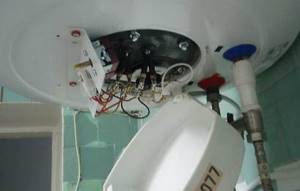
Sometimes a tee with a valve is cut into a section of the tube to the safety valve.
Algorithm of actions:
- turn off the network, turn off the supply, open the tee valve;
- open the hot line tap on the mixer, the flow will flow through it;
- the valve on the tee is not closed to allow air to flow;
- The shut-off valve is closed after the end of the drain.
The procedure lasts several hours. It is accelerated by removing the sleeve from the cold feed tube.
A quick draining method is through two pipes. The cold and hot branches are disconnected sequentially. The liquid simultaneously leaves two pipes, the tank is emptied quickly. With such a drain, there is no control over the flow intensity, so the method is used if the boiler hangs above the bathtub.
Boiler breakdown

At first (about two years), the structure does not require maintenance, then signs of poor-quality operation of the unit appear. The water takes on a rusty tint, there is sand and scale particles. If the tap fluid is of poor quality, cleaning will be required much sooner.
Landmarks indicating the need for prevention:
- The heating element begins to make noise when turned on;
- the device turns on and off more often than usual, the fuse trips;
- heating time increases;
- When used, it gives an electric shock and the housing leaks.
The cover is removed after unscrewing the bolts near the fittings, the power supply circuit becomes visible. The thermostat is located here, which can be removed with a sharp downward movement.
Checking for correct operation
It’s great if the water heater is connected to a separate machine. If problems arise in its operation, this will not affect the power supply to other appliances in the house.
If after starting the heater the circuit breaker is knocked out, you can turn it on again. If the situation repeats itself, then there is a serious problem. The unit must be de-energized and a technician must be called.
Here are a few more details that need to be checked after putting the boiler into operation:

- Inspect the hot water pipe to see if there is a leak. The fact is that a water heater can create more pressure than in risers. And if the gaskets are already worn out somewhere, but withstood the load from the central water supply, now they can give up.
- Make sure that the light indicating the supply of voltage to the heating element comes on.
- Take readings of how many degrees the meter shows at the very beginning of operation of the device, and then look at the temperature again after 20 minutes. If the data has increased, the heating element has successfully survived the rest period and is heating properly.
Due to their compact size and ease of use, instantaneous water heaters are in great demand. But you need to correctly assess your capabilities before deciding to install such a device yourself, because this process requires compliance with a number of rules. How to connect an instantaneous water heater: installation tips, read carefully.
You may be interested in the following information: how to drain water from a water heater and when it is necessary, read here.
Read about connecting the water heater to the water supply and to the electrical network here: https://microklimat.pro/otopitelnoe-oborudovanie/vodonagrevateli/ustanovka-svoimi-rukami.html. And also everything about choosing a place for the boiler.
Features of turning off various boiler models
Sometimes the manufacturer does not allow the user to turn off the boiler, otherwise the warranty period will no longer apply. Each model has its own characteristics that you need to know in order to perform the drain yourself.
Ariston

First, screw off the plug at the top of the mixer and close the cold branch, the water mixer taps, and remove the shower hose. At the outlet and inlet, the valve is removed and the plastic nuts are screwed together. After removing the cap on the mixer, the screw is turned out, the handle and gaskets are removed.
The boiler body is disconnected from the container inside, but cannot be removed. The plug is opened and the drain occurs through the hole that appears. To ensure air flow, the tap does not close.
Termex
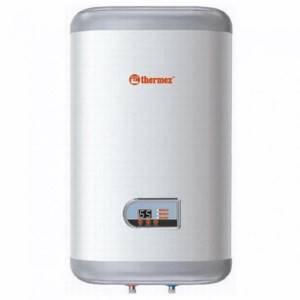
To properly turn off the Termex boiler, you need to remove the touch screen. The cable connects the control board and the external board; it is disconnected from the power module and a thin 1.5 meter cord is connected. After this, remove the touch screen sticker, the display device panel on the screws becomes visible.
The hardware is unscrewed, the module and cable are removed using a cord. The heating element is attached to one nut, which is unscrewed counterclockwise.
Electrolux
Draining is done through a standard hole in the safety valve or a pre-cut tap is used. The cold water supply and power supply are turned off. At the level of the drain sleeve, a pipe is placed through which the liquid flows. The hose is placed in the sink, bathtub or toilet.
Other
Gorenje brand boilers are drained according to a standard algorithm. The power supply and the tap from which hot liquid flows are turned off. After the water has been completely removed, a hose is put on the cold pipe and led into the drain tank. The cold supply valve is opened to allow air to enter, allowing any residue to drain out.
Removing liquid from an Acquaverso heater is not difficult if the attachment and connection have been made correctly. The algorithm is standard - turn off the water, turn off the power to the boiler, drain the liquid through the valve.
Turning on the water heater without water
Many users are concerned about what to do if they turn on the boiler without water. If you forget to fill the boiler tank with water when you turn it on, it will not turn off automatically. The temperature sensor will detect the air temperature in the room (20-25 degrees), take this indicator as the water temperature and will not recognize errors. What will happen? The most unpleasant consequence of the lack of water in the water heater can be the burnout of the heating element. If such a breakdown occurs, it is unlikely to be repaired even under warranty.






